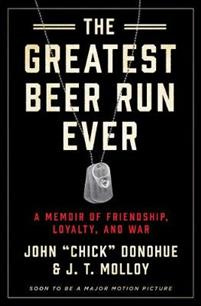Book Review: The Greatest Beer Run Ever by John “Chick” Donohue and J. T. Malloy
An epic quest through war-torn Vietnam
The Greatest Beer Run Ever: A Memoir of Friendship, Loyalty, and War by John “Chick” Donohue and J. T. Malloy. Narrated by Malcolm Hillgartner. HarperAudio, 2020. 6 hours (approx.).
The Greatest Beer Run Ever by John “Chick” Donohue and J. T. Malloy is the true story of Donohue’s trip into wartime Vietnam to deliver his friends a can of hometown beer.
Decades of tensions within Vietnam, including its occupation by Japan during World War II and France’s attempt to reclaim the country afterward, led to the rise of communist revolutionary Ho Chi Mihn and the Viet Minh independence movement. The “domino theory,” which was popular in the United States during the 1950s, suggested communism would spread all over southeast Asia. Involvement in Vietnam, therefore, was part of the U.S.’s strategy of containment.
John Donohue - better known as Chick or Chickie - grew up in Inwood, Manhattan, a close-knit community where politics and religion were, “cut from the same sacred cloth.” If you were asked to fight communism, he says, it was your duty to go.
Twenty-eight local boys were killed in Vietnam by 1967. Moreover, anti-war protesters became anti-soldier. Donohue recalls, “We were told that when the neighborhood boys had gone down to the draft board on Whitehall Street...they had been met by picketers carrying signs that read ‘GIs are murderers.’”
One night, in November of ‘67, the bartender of Doc Fiddler’s had enough. George Lynch was a super patriot. He raised a flag every day and always had a spare bed for a returning soldier. He organized several parades. He said, “‘Somebody ought to go over to ‘Nam, track down our boys from the neighborhood, and bring them each a beer.’” The bar patronage cheered. But how could it be done? Civilians could not just visit Vietnam willie-nillie.
John “Chick” Donohue volunteered. He was a merchant seaman and former Marine. He had been to the country before. He used his seaman’s credentials to get work as an oiler on a cargo ship bound for Vietnam. While the vessel was unloading, he got leave to visit a “stepbrother” in the army. For the next eight weeks, Chick would travel the country to find his friends, give them news and good tidings as well as the beer.
The trip was miraculous. He found a couple friends almost immediately off the ship. Some officers he met along the way assumed Chick to be a CIA agent. Chick never asserted that he was but he also never denied it. This mistaken identity helped him get along his journey. He made friends with locals, fed people with food he secreted from another cargo ship, and had a romantic evening with a woman on lunar new year’s eve.
But Donohue’s ship left without him. He was stranded. He needed another way out of Vietnam. The second half of the book follows Chick as he navigates bureaucratic red tape trying to get a passport and the permission to be airlifted to the Philippines where a boat will take him home. But on the day he was to report to the U.S. embassy for departure, the Viet Cong launched the Tet offensive.
A force of 84,000 attacked 100 towns and key military sites across the country. Several thousand attacked Saigon where Chick was located. For three months the Viet Cong had prepared by sneaking weapons into Saigon in vegetable trucks and soldiers disguised as travelers visiting home for the new year. The U.S. knew of, but underestimated how big the attack would be.
A civilian without weapons or gear, Chick sheltered against the walls of the U.S. embassy in the middle of a firefight, soldiers falling all around him.
Donohue eventually got passage on a boat home.
He found four out of six of the neighborhood boys on his list. One had been sent home with malaria, the other had been killed. Chick and the four boys - now old men - still occasionally get together and reminisce about the greatest beer run ever.
Look for the movie adaptation directed by Peter Farrelly.



